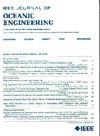An Efficient Drifters Deployment Strategy to Evaluate Water Current Velocity Fields
IF 3.8
2区 工程技术
Q1 ENGINEERING, CIVIL
引用次数: 0
Abstract
Water current prediction is essential for understanding ecosystems, and to shed light on the role of the ocean in the global climate context. Solutions vary from physical modeling, and long-term observations, to short-term measurements. In this article, we consider a common approach for water current prediction that uses Lagrangian floaters for water current prediction by interpolating the trajectory of the elements to reflect the velocity field. Here, an important aspect that has not been addressed before is where to initially deploy the drifting elements such that the acquired velocity field would efficiently represent the water current. To that end, we use a clustering approach that relies on a physical model of the velocity field. Our method segments the modeled map and determines the deployment locations as those that will lead the floaters to “visit” the center of the different segments. This way, we validate that the area covered by the floaters will capture the inhomogeneity of the velocity field. Exploration over a dataset of velocity field maps that span over a year demonstrates the applicability of our approach, and shows a considerable improvement over the common approach of uniformly randomly choosing the initial deployment sites. We share our Python implementation code for reproducibility in (Jubran et al., 2022).评估水流速度场的高效漂流器部署策略
水流预测对于了解生态系统和阐明海洋在全球气候中的作用至关重要。从物理建模、长期观测到短期测量,解决方案各不相同。在本文中,我们考虑了一种常见的水流预测方法,即使用拉格朗日浮子通过插值元素轨迹来反映速度场,从而进行水流预测。在此,一个以前未曾涉及的重要问题是,最初应在何处部署漂流元件,从而使获取的速度场有效地代表水流。为此,我们采用了一种依靠速度场物理模型的聚类方法。我们的方法对模型地图进行分段,并根据浮子 "访问 "不同分段中心的情况确定部署位置。通过这种方法,我们可以验证浮标覆盖的区域能够捕捉到速度场的不均匀性。对跨度超过一年的速度场地图数据集的探索证明了我们的方法的适用性,并显示出与统一随机选择初始部署点的常见方法相比,我们的方法有了相当大的改进。我们在(Jubran 等人,2022 年)中分享了我们的 Python 实现代码,以实现可重复性。
本文章由计算机程序翻译,如有差异,请以英文原文为准。
求助全文
约1分钟内获得全文
求助全文
来源期刊

IEEE Journal of Oceanic Engineering
工程技术-工程:大洋
CiteScore
9.60
自引率
12.20%
发文量
86
审稿时长
12 months
期刊介绍:
The IEEE Journal of Oceanic Engineering (ISSN 0364-9059) is the online-only quarterly publication of the IEEE Oceanic Engineering Society (IEEE OES). The scope of the Journal is the field of interest of the IEEE OES, which encompasses all aspects of science, engineering, and technology that address research, development, and operations pertaining to all bodies of water. This includes the creation of new capabilities and technologies from concept design through prototypes, testing, and operational systems to sense, explore, understand, develop, use, and responsibly manage natural resources.
 求助内容:
求助内容: 应助结果提醒方式:
应助结果提醒方式:


